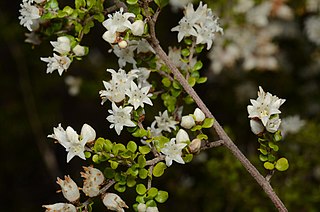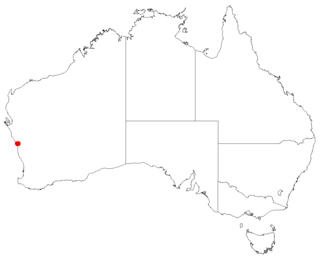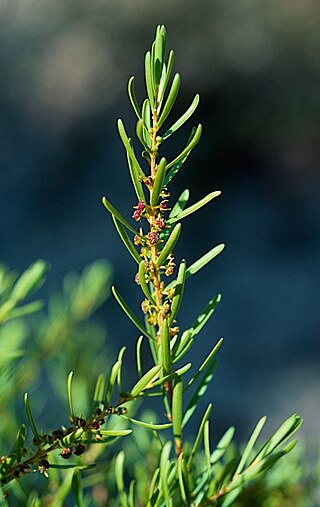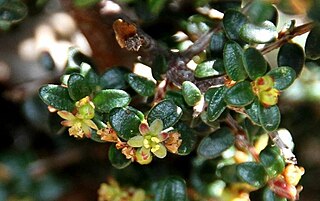
Stachystemon is a genus of nine species of flowering plants in the family Picrodendraceae, and is endemic to Western Australia. Plants in the genus Stachystemon are monoecious shrubs with simple, usually thickened leaves, and flowers arranged singly or in small groups in upper leaf axils, male flowers usually with four to six tepals, usually with seven to many stamens, and female flowers with four or six tepals and two styles in each flower.
Hibbertia atrichosepala is a species of flowering plant in the family Dilleniaceae and is endemic to a restricted area in the south-west of Western Australia. It is an upright shrub with crowded linear to tapering leaves and yellow flowers arranged singly in leaf axils with glabrous sepals and the five stamens all on one side of the two carpels.
Cryptandra ciliata is a species of flowering plant in the family Rhamnaceae and is endemic to south-eastern Queensland. It is a shrub with clustered linear leaves and densely-hairy, white, tube-shaped flowers.
Cryptandra gemmata is a species of flowering plant in the family Rhamnaceae and is endemic to the far north of the Northern Territory. It is a shrub with clustered linear leaves and white to creamy-white, tube-shaped flowers.

Cryptandra orbicularis is a species of flowering plant in the family Rhamnaceae and is endemic to south-eastern Queensland. It is a shrub with more or less round or kidney-shaped leaves and white to creamy-white, tube-shaped flowers.

Leucopogon navicularis is a species of flowering plant in the heath family Ericaceae and is endemic to the southwest of Western Australia. It is an erect, compact shrub with hairy young branchlets, narrowly elliptic to narrowly egg-shaped leaves and erect, compact clusters of 4 to 12 white, bell-shaped flowers in upper leaf axils or on the ends of branches.
Ricinocarpos brevis is a species of flowering plant in the family Euphorbiaceae and is endemic to inland Western Australia. It is a monoecious, densely-branched shrub with narrowly oblong leaves and male and female flowers arranged singly or in small groups.
Ricinocarpos graniticus is a species of flowering plant in the family Euphorbiaceae and is endemic to the southwest of Western Australia. It is a monoecious shrub with linear leaves and creamy white flowers, arranged either singly, or with a single female flower surrounded by one or two male flowers.
Micromyrtus albicans is a species of flowering plant in the myrtle family, Myrtaceae and is endemic to a small area of south-eastern Queensland. It is a slender shrub with overlapping, egg-shaped leaves and small white flowers.

Ricinocarpos linearifolius is a species of flowering plant in the family Euphorbiaceae and is endemic to eastern Australia. It is a monoecious or dioecious shrub with hairy young branchlets, linear leaves and white flowers, arranged either singly, with two to four male flowers, or a single female flower surrounded by up to three male flowers.
Pseudanthus ballingalliae is a species of flowering plant in the family Picrodendraceae and is endemic to Queensland. It is a monoecious shrub with simple, oblong to narrowly oblong leaves and small yellow male and green female flowers arranged singly in upper leaf axils, but appearing clustered on the ends of branches.

Stachystemon axillaris, commonly known as leafy stachystemon, is a species of flowering plant in the family Picrodendraceae and is endemic to the south-west of Western Australia. It is a monoecious shrub with simple, linear to narrowly elliptic or oblong leaves and small yellow flowers arranged singly in upper leaf axils.

Pseudanthus ligulatus is a species of flowering plant in the family Picrodendraceae and is endemic to northern Queensland. It is a monoecious shrub with simple, lance-shaped or linear to narrowly oblong leaves and creamy white male and pale green female flowers arranged singly in upper leaf axils, but appearing clustered on the ends of branches.
Stachystemon brachyphyllus is a species of flowering plant in the family Picrodendraceae and is endemic to the south-west of Western Australia. It is a monoecious shrub with simple, narrowly elliptic to elliptic or oblong leaves and small yellow, red, purple and brown flowers arranged singly in upper leaf axils.
Micromyrtus capricornia is a species of flowering plant in the myrtle family, Myrtaceae and is endemic to a small area of central eastern Queensland. It is a shrub with slightly drooping branchlets, overlapping, narrowly egg-shaped leaves and small white flowers.
Ricinocarpos oliganthus is a species of flowering plant in the family Euphorbiaceae and is endemic to a small area in the south-west of Western Australia. It is a monoecious shrub with linear to narrowly oblong leaves and white to creamy white flowers arranged singly on the ends of branchlets.
Pseudanthus micranthus, commonly known as fringed pseudanthus, is a species of flowering plant in the family Picrodendraceae and is endemic to the south-east of South Australia. It is a compact, monoecious shrub with simple, egg-shaped to round leaves and yellow flowers arranged in leaf axils, but appearing clustered on the ends of branches.
Ricinocarpos pilifer is a species of flowering plant in the family Euphorbiaceae and is endemic to a small area in the south-west of Western Australia. It is a compact monoecious shrub with narrowly oblong leaves and creamy white flowers arranged singly, or with two to four male flowers, or a single female flower with one or two male flowers.

Pseudanthus orbicularis is a species of flowering plant in the family Picrodendraceae and is endemic to south-eastern continental Australia. It is a compact, monoecious shrub with simple, broadly elliptic to round leaves and creamy white, red or pale red flowers arranged singly in upper leaf axils.
Stachystemon mucronatus is a species of flowering plant in the family Picrodendraceae and is endemic to the south-west of Western Australia. It is a compact, monoecious shrub with narrowly oblong or narrowly elliptic leaves and small, greenish yellow flowers arranged singly in upper leaf axils.






